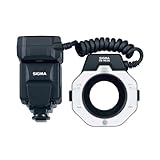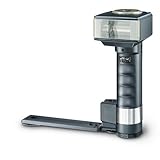You find that you are often limited by your camera in-built and sometimes you feel envious that other people can produce a good picture with natural lighting with their external flash as opposed to your harsh lighting with your built in flash. You would also like to expand your creativity by experimenting with the different lighting. You have read that there are many ways to play with the flash and are excited that you can expand your creativity to the different ways flash is used. You would like to take that type of photo you have seen on the Internet but you will have to do a research to find out what sort of flash are available on the market to suit your needs. In this section will introduce the different flash available in the market.
There are four main types of flash available on the market:
Handle mount flash
Handle- mount flash traditionally is more powerful than the shoe-mount flash and communicates via a cable. The disadvantages are that it usually mounted on one side of the camera and they can be quite distracting to use. They are difficult to store as they are quite big in size.
Shoe-mount flash
This type of flash is most commonly used and is very easy to bring due to their small size. This flash communicates with the camera via shoe-mount which is found on top of your camera. You can also purchase a wireless trigger to achieve a wireless photography or you can purchase an off camera shoe cable so that you can place your flash at a different angle if you do studio photography.
Ring macro flash
As the name suggested, this flash is generally used for macro shot. It is shaped like a ring and the flash is either with attached to the ring or is found in the ring. Usually this flash is less powerful as compared to the rest of the flash available.
Strobe flash
Strobe flash is commonly used for studio photography. They are more bulky and consumed more power than the rest of the flash mentioned above. If you ever want to take a professional portrait or earn some money as a studio photographer, then you should consider purchasing this flash. Take note that this type of flash is not cheap and if you really want to try out studio photography, try getting a few small compact flashes instead of strobe flash.



Most of the flashes available in the market use guide number to indicate how powerful the flash is. Pay attention to the guide number of each flash, as a high guide number indicates a powerful flash. There is also some additional flash features that you can take note of. Some flashes offer you a complete manual control such as the freedom to set your own flash output, the ability to use different flash types (i.e High speed flash, 2nd synchronisation flash, bounce flash, etc) while other flashes will not be able you to set manually. There are some in-built diffusers such as a mini bounce card available in the flash. They are very useful if you want to shift some part of the light to light up your object to achieve natural lighting.
Conclusion
If you really feel that your in-built flash is insufficient or you want to branch into flash photography, then get flash. For a start, getting a shoe-mount flash is good as they are light, compact and easy to carry around which makes them popular. Once you have become experienced in handling flash, you might want to consider upgrading to other types of flashes.
Welcome to the Digital Photography Academy! This site offers some tips and techniques to improve one's photography skills and some creative ways to manipulate pictures and shooting styles. For a start, feel free to look at the terminology guide.
 Subscribe in a Digital Photography Academy
Subscribe in a Digital Photography Academy
Recent updates
Tuesday, June 16, 2009
Flash buying guide
Subscribe to:
Post Comments (Atom)

0 comments:
Post a Comment